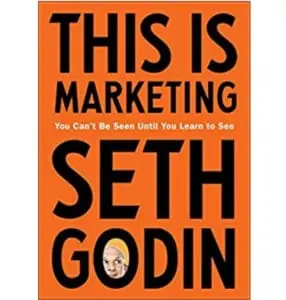
No time to read? Here are our team’s top takeaways.
Marketing is not a battle
For years, marketing gurus preached marketing was battle—a war of words, a skirmish around mindshare, a struggle for publicity. Godin argues that the most effective marketing helps someone resolve their problem.
Embrace the smallest viable audience
“Everything gets easier when you walk away from the hubris of everyone. Your work is not for everyone. It’s only for those who signed up for the journey.”
This is one near and dear to me because our agency lived it and reaped the benefits. Five years ago we focused on a three-legged verticals stool of biotech, health IT, and SaaS. We gave up good clients and revenue from law firms.
And you know what happened? We more than doubled our business because we had more time to engage with clients in our chosen verticals and we were seen as experts in this space.
Too often I see small-to-midsize companies trying to sell and market to five to ten industries at any given time, with a marketing budget that just can support the consumer’s new expected model of engagement.
Instead, do some preliminary research and choose your smallest feasible audience. Then get into their psyche, hopes, and dreams. Once you have a message continually test, but stick with your marketing strategy and campaigns to this audience for at least a year…two years in extended sales cycle industries like healthcare technology.
“...great marketing is the generous and audacious work of saying “I see a better alternative; come with me.” - Seth Godin Share on XArticulate your marketing promise
Similar to Simon Sinek’s Golden Circle, Godin’s marketing promise template boils down a brand statement into three sentences:
My product is for people who believe ______________________.
I will focus on people who want __________________________.
I promise that engaging with what I make/deliver will help you get _____________________.
Choose your promises wisely. And make sure you can deliver on that promise. Does your content give what it says it will? If a customer buys your product, will they be able to achieve what you said they would? Don’t make your promises too grand, but make them achievable and make them matter to your audience.
“When someone doesn’t act like you expect them to, look for their fear.” - Seth Godin Share on XOwn your content
Don’t send emails or content from a generic corporate email address. Own it and personalize it. Your content should come from a real human being and sound like it. I recently started writing personal intros to our monthly e-newsletter as a way to increase engagement. Plus, I enjoy the opportunity of speaking to all our clients and colleagues directly.
“When you’re marketing change, you’re offering a new emotional state; a step closer to the dreams and desires of your customers…” - Seth Godin Share on XProfessional design makes you fit in with the right amount of magic
Many clients ask us for a brand identity or website design that’s “totally different” than other competitive offerings. Or make us look like Tesla? But is this effective? Godin argues not necessarily.
Your design and messaging needs to make customers feel safe or feel like a product we already trust. On top of this safety net, you can throw in your intended message and value propositions.
This protection of competence, safety, and trust are especially important in medical device and healthcare technology marketing. Buyers in these highly-regulated industries want vendors they can count on; not necessarily innovation that has inordinate risk.
If you’re Tesla, then your audience is very willing to assume risk in exchange for status and the cool factor. If your audience is a patient safety director, they want to trust you and feel a sense of “I’ve seen this before.”
You can find a balance by aiming to be different enough to stand out, but familiar enough to be taken seriously.
In summary: a simple marketing worksheet
There’s a quick worksheet with questions that summarizes the entire book at the end before the Acknowledgments. Every company leadership team should take the time to complete this questionnaire and the positioning exercise in Chapter Five with the marketing team.
Plant your flag
If you’re ready to plant your flag, we’re ready to help.
“What’s your flag? Why would someone fly it?” - Seth Godin Share on X

